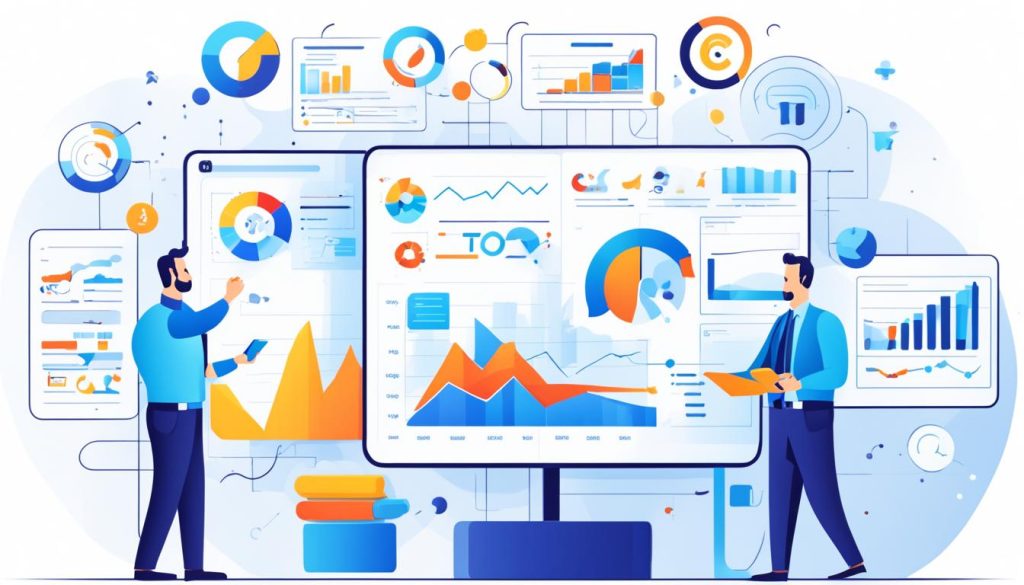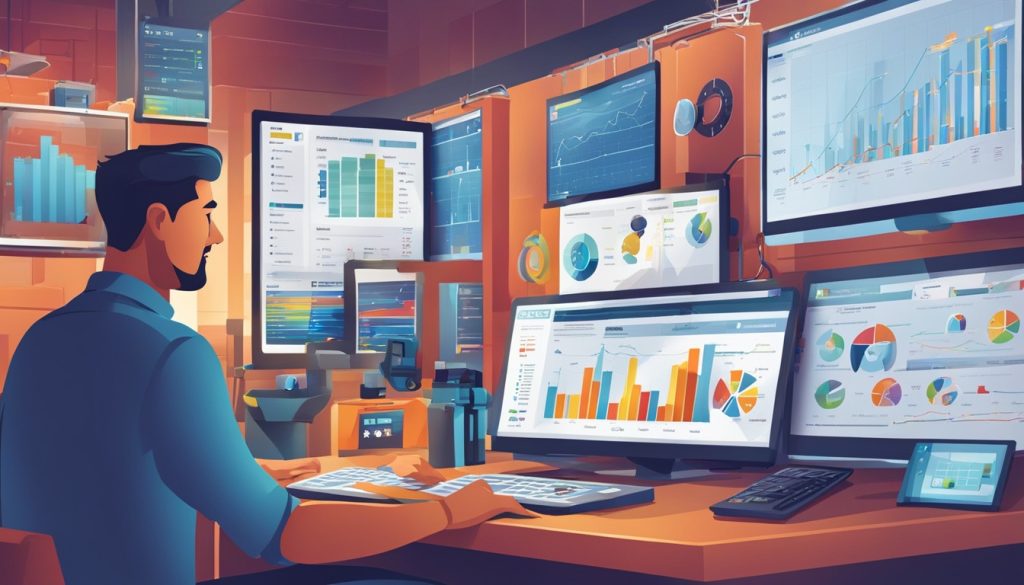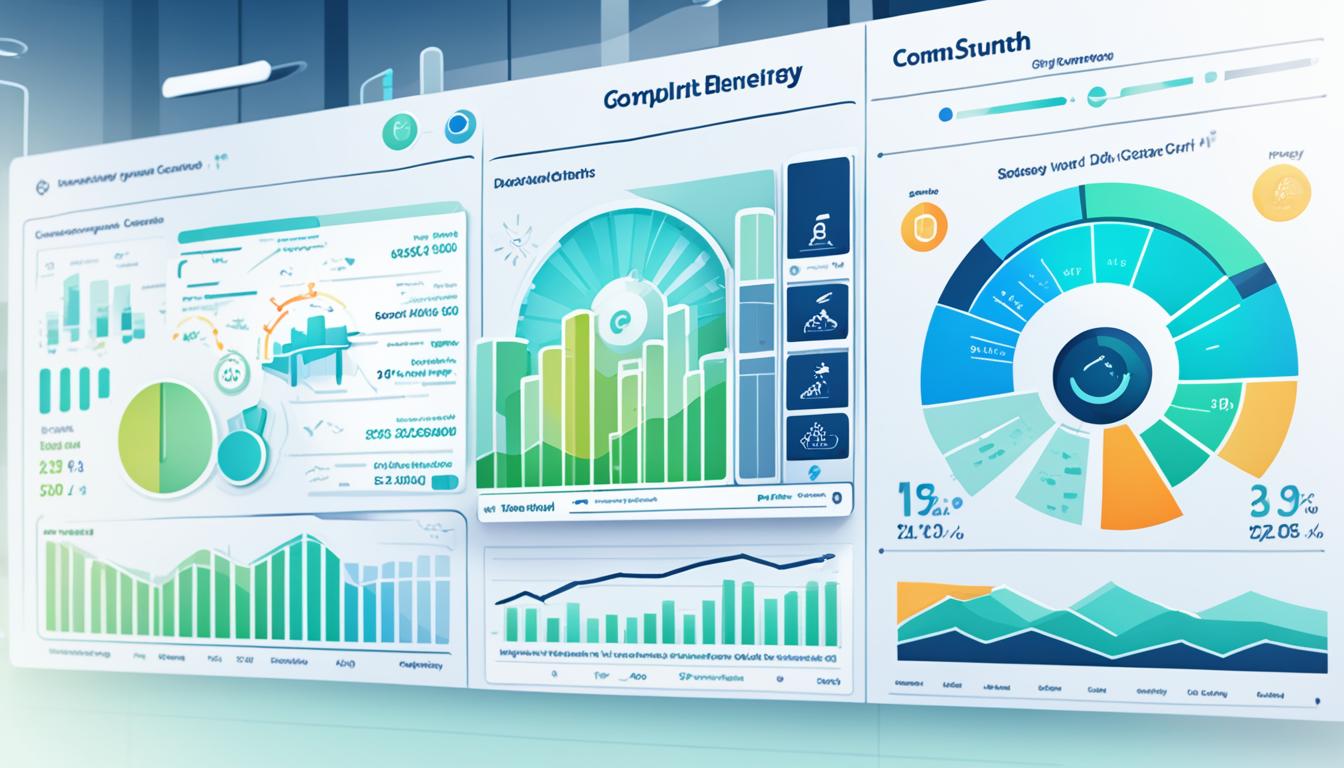Using CRM analytics can help your HVAC business grow. This method lets you improve how you talk to customers, plan your services better, and manage your inventory well.
CRM analytics give you deep insights into what your customers like. This helps you beat your competitors in sales. You can also predict when equipment might break down, improve how you serve customers, and make your operations smoother.
The big data market is set to hit $103 billion by 2027. This makes data-driven strategies key for HVAC businesses to grow. By using CRM analytics, you can find new chances to grow and stay ahead in the competitive HVAC market.
Understanding the Power of CRM Analytics in HVAC
CRM analytics is changing the HVAC industry. It uses CRM data to give businesses key insights. This helps companies make better decisions, improve customer service, and increase sales.
What is CRM Analytics?
CRM analytics looks at data from your CRM system. It uncovers what customers like, want, and need. For HVAC companies, it tracks service history, equipment performance, and how happy customers are.
Benefits of CRM Analytics for HVAC Businesses
CRM analytics brings big benefits to HVAC companies:
- Improved customer service through tailored interactions
- More efficient scheduling and dispatching of technicians
- More revenue by finding ways to sell more
- Smarter inventory management based on trends
- Targeted marketing campaigns based on customer data
Key Features of CRM Analytics Tools
Good CRM analytics tools for HVAC businesses have:
- Tracking for leads to improve marketing
- Automated scheduling to cut down on work
- Management of work orders for better service
- Reporting and dashboards for fast insights
- Customer portals for better communication and satisfaction
Using CRM analytics, HVAC companies can stand out. It helps them offer top-notch service, run more smoothly, and make choices based on data for growth.
Leveraging Customer Data for Business Growth
Using customer data can change the game for HVAC businesses. It helps them grow in a tough market. Let’s see how you can use customer info to boost your HVAC business.
Understanding your market and customers is key with HVAC sales analytics. By looking at sales data, you can spot trends and what customers like. This lets you make your services and marketing just right for your customers.
Customer behavior holds lots of useful info. By looking at these patterns, you can guess what services you’ll need and how to keep customers happy. For instance, you might find that some HVAC systems need more upkeep in certain areas. This lets you contact customers there first.
| Data Source | Insights Gained | Business Impact |
|---|---|---|
| Website Analytics | User engagement, popular services | Improved website design, targeted content |
| Sales Data | Top-selling products, seasonal trends | Optimized inventory, strategic promotions |
| Customer Feedback | Service quality, pain points | Enhanced customer experience, service improvements |
A strong CRM system helps you keep an eye on sales, track important numbers, and manage your sales process. This gives you a clear view of your business. It lets you make smart, data-based choices fast.
It’s not just about collecting data; it’s about using it to make your business better. By using data wisely, you can get new customers, keep the ones you have, and stay ahead of rivals.
Implementing a Data-Driven Culture in Your HVAC Company
Creating a data-driven HVAC company culture is crucial to stay ahead. It helps you make smart choices and run better. Let’s see how to build this mindset and support your team.
Cultivating a Data-First Mindset
Make data a big part of your business. Use numbers to help with everything from service calls to managing stock. Ask your team to support their ideas with data. This change can make things more efficient and improve customer service.
Training Your Team on Data Analytics
Invest in training your HVAC team on data analytics. This will help them use data tools well. They’ll learn to turn numbers into useful insights. A skilled team can increase efficiency by up to 10%.
- Offer workshops on data interpretation
- Provide hands-on experience with analytics tools
- Encourage sharing of data-driven success stories
Overcoming Resistance to Change
Some team members might not like new data-driven ways. Talk about their concerns openly. Explain how data can make their jobs easier and more effective. Mention success stories from other HVAC companies that use data analytics.
Building a data-driven culture takes time. Stay patient and keep at it. With the right steps, your HVAC business could be part of the 24% of companies with a strong data culture. This could double your chances of meeting your goals.
Selecting the Right CRM Analytics Tool for Your HVAC Business
Finding the right CRM tools for HVAC can change the game for your business. You need a system that handles customer relationships and gives insights for growth. Let’s look at how to choose the best HVAC business software for your company.

- Features aligned with your specific HVAC needs
- Scalability to grow with your business
- User-friendly interface for quick team adoption
- Integration capabilities with existing systems
- Robust reporting and analytics tools
Popular CRM platforms like GoHighLevel have features made for HVAC companies. They offer job scheduling, tracking customer history, and analytics. Solutions like Jobber and Housecall Pro are made for HVAC businesses. They have tools for managing services and dispatch.
| CRM Tool | Key Features | Best For |
|---|---|---|
| GoHighLevel | All-in-one marketing and CRM | Growing HVAC businesses |
| Jobber | Job scheduling, invoicing | Small to medium HVAC companies |
| Housecall Pro | Mobile-first, customer portal | Tech-savvy HVAC teams |
The right HVAC business software should make your work easier, help with customer service, and give useful insights. Take time to try out different options and get your team involved in choosing. This way, you make sure the CRM fits everyone’s needs.
Make Data-Driven Decisions with CRM Analytics
CRM analytics help HVAC businesses make smart choices with solid data. They give you deep insights into your customers. This lets you change how you work and increase profits.
Analyzing Customer Behavior Patterns
Looking into HVAC customer behavior shows important trends. You can see what services they like, when they need them, and what they buy. This helps you make your services better and keep customers happy.
- Identify most popular services
- Discover peak demand periods
- Spot upselling opportunities
Predicting Service Demands and Trends
Predicting when you’ll need to serve customers is key for HVAC companies. Use past data and market trends to guess what you’ll need in the future. This helps you get ready and make sure you have enough staff and resources.
| Season | Predicted Demand | Top Service |
|---|---|---|
| Summer | High | AC Maintenance |
| Winter | High | Heating Repairs |
| Spring | Moderate | System Tune-ups |
| Fall | Low | Duct Cleaning |
Optimizing Pricing Strategies
Setting the right prices for HVAC services is important. Look at what others charge, how much it costs you, and what customers are willing to pay. Change your prices based on how busy you are, the time of year, and how complex the service is.
Using CRM analytics, you can make choices that help your HVAC business grow and make customers happier.
Enhancing Customer Service with CRM Insights
CRM insights can change how you improve your HVAC customer service. By using customer data, you can answer faster, schedule more efficiently, and give personalized advice. Let’s see how CRM can make your business better.
CRM systems keep important info about your customers, like their service history and what equipment they have. This info helps your team give top-notch service. When a customer calls, you can quickly look up their info, guess what they need, and offer solutions just for them.
Modern CRM solutions also have customer portals. These let customers see their service history, set up appointments, and pay online. This makes things easier for them and helps your team too.
| CRM Feature | Customer Service Benefit |
|---|---|
| Customer History | Personalized service recommendations |
| Equipment Details | Faster issue diagnosis |
| Customer Portal | 24/7 self-service options |
| Automated Reminders | Improved maintenance scheduling |
Using these CRM strategies can really boost customer happiness. Your team will be ready to answer questions, fix problems fast, and offer services ahead of time. This not only makes customers more loyal but also makes your HVAC business stand out.
Streamlining Operations through Data-Driven Processes
Optimizing HVAC operations is key to growing your business. Using data-driven HVAC processes can make your operations smoother and more efficient. Let’s see how CRM analytics can change your HVAC business for the better.
Improving Technician Scheduling and Dispatch
CRM analytics are great for improving how you schedule technicians. By looking at past data, you can guess when you’ll need the most help. This means you can plan better and make customers happier faster.
Optimizing Inventory Management
Having the right parts when you need them is crucial. CRM systems track how often you use parts. This helps you keep just enough stock, cutting down on waste and making sure technicians have what they need.
Enhancing Maintenance Planning
Predictive maintenance is a big win for HVAC businesses. CRM analytics spot patterns in how equipment works. This lets you fix things before they break, cutting down on downtime and making equipment last longer.
| Process | Benefits |
|---|---|
| Technician Scheduling | Faster response times, improved customer satisfaction |
| Inventory Management | Reduced waste, increased efficiency |
| Maintenance Planning | Minimized downtime, extended equipment life |
By using data-driven HVAC processes, you’re setting your business up for success. CRM analytics give you the insights you need to make smart choices. This leads to better operations and happier customers.
Boosting Marketing Effectiveness with CRM Data
CRM data changes the game for HVAC marketing strategies. It lets you create campaigns that really speak to your audience. Let’s see how CRM-driven campaigns can change your HVAC business for the better.

CRM systems are great for finding new customers. They collect contacts from many places, giving you a big list. With this info, you can make marketing messages that really connect with different parts of your audience.
CRM platforms also have tools to make marketing easier. You can set up emails that go out automatically to leads. These emails keep your HVAC services in front of customers when they need them.
| CRM Feature | Marketing Benefit |
|---|---|
| Lead Capture | Expanded customer base |
| Automated Emails | Consistent lead nurturing |
| Analytics | Data-driven optimization |
CRM analytics show how well your campaigns are doing. You’ll see which strategies work best and where to improve. This helps you make the most of your marketing budget.
Using CRM data means you’re marketing smarter, not just harder. Your HVAC business can reach the right customers at the right time. This leads to more conversions and a bigger customer base.
Measuring and Improving Sales Performance
Tracking HVAC sales performance metrics is key to growing your business. CRM sales analytics offer powerful tools to measure and boost your team’s effectiveness. Let’s see how to use these insights for better results.
Tracking Key Performance Indicators (KPIs)
CRM systems let you keep an eye on important KPIs for sales success. Look at lead conversion rates, average deal size, and sales cycle length. By checking these numbers, you can find areas to improve and set goals for your team.
Identifying Sales Opportunities
CRM analytics show you where the best opportunities are in your sales pipeline. Use data to pick leads by their budget, timeline, and project scope. This way, your team focuses on the most promising prospects, boosting close rates and revenue.
Conducting Effective Performance Reviews
Use CRM data for deep performance reviews. Make one-page sales performance reports for each team member. These reports lead to good discussions, highlighting strengths and growth areas. Use this info for targeted coaching plans and help your sales reps do better.
| KPI | Target | Actual |
|---|---|---|
| Lead Conversion Rate | 25% | 22% |
| Average Deal Size | $5,000 | $4,750 |
| Sales Cycle Length | 30 days | 35 days |
By using CRM sales analytics, you can make data-driven choices to boost your HVAC business’s sales. Regularly check these metrics and tweak your strategies to stay ahead in the market.
Utilizing Real-Time Analytics for Agile Decision Making
Real-time HVAC analytics change how you manage your business. They let you make quick, smart choices to stay ahead. Let’s see how agile decision-making in HVAC can improve your operations.
Real-time analytics give you a steady flow of important information. You can watch customer interactions, track service requests, and look at sales as they happen. This lets you make the most of your HVAC business right away.
Optimizing Service Routes
With real-time data, planning and changing technician routes becomes easier. This cuts down on travel time and lets you complete more service calls each day. Your team can quickly change plans for new emergencies or delays.
Emergency Response Efficiency
Agile decision-making in HVAC is key in emergencies. Real-time analytics help you find the closest technician and send them fast. This quick action boosts customer happiness and can grow loyalty.
Dynamic Marketing Strategies
Real-time HVAC analytics let you change your marketing based on quick feedback. You can see which ads work and adjust the ones that don’t. This keeps your marketing budget in check and effective.
| Aspect | Without Real-Time Analytics | With Real-Time Analytics |
|---|---|---|
| Service Route Planning | Static, pre-planned routes | Dynamic, adaptable routes |
| Emergency Response | Delayed, based on availability | Immediate, nearest technician dispatched |
| Marketing Adjustments | Monthly or quarterly changes | Instant tweaks based on performance |
By using real-time HVAC analytics, you can quickly adapt to market changes. This agility can lead to better customer service, more efficiency, and a stronger bottom line.
Overcoming Challenges in Implementing CRM Analytics
Adopting CRM analytics can change the game for your HVAC business, but it comes with challenges. Companies often struggle with CRM implementation and HVAC data analytics. The first step is to identify these issues and make a plan to overcome them.
Resistance to change from your team is a common problem. To fix this, involve your staff early in the process. Explain how data-driven decisions can make their work easier. Offer training sessions to help them feel confident with the new tools.
Data quality issues can also hinder your analytics efforts. Make sure your CRM system has strong data validation features. Regularly check and clean your data to keep it accurate. This ensures you make informed decisions, not ones based on wrong information.
Integrating with existing systems is another big challenge. Pick a CRM platform that easily connects with your current software. This makes your workflows smoother and prevents data from getting stuck in silos. Remember, solving these problems is an ongoing task, but the benefits of better efficiency and happier customers make it worthwhile.





0 Comments